Marcus P. Corrosion mechanisms in theory and practice
Подождите немного. Документ загружается.

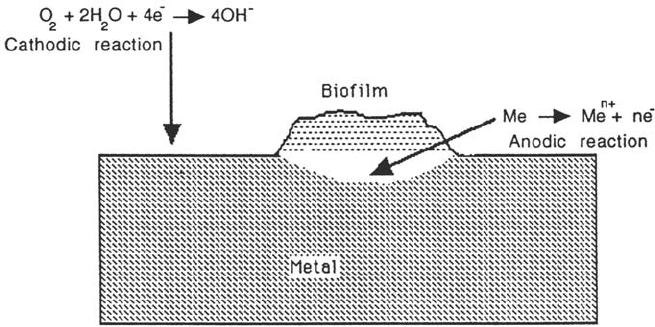
corrosion processes. However, it is now well known that bacteria are not found in
isolation but rather in consortia or biofilms in which many bacterial communities
coexist. A good illustration of this is given in Figure 7 [21]. As already mentioned,
a biofilm is composed mainly of bacterial cells, extracellular polymers, inorganic
ions, and water. It influences the mass transfer of different species and in particular
dissolved oxygen from the solution to the metal, thereby creating a zone depleted
in oxygen at the metal–biofilm interface (Fig. 7a). In this part of the biofilm,
facultative and obligate anaerobic microorganisms such as sulfate-reducing bacteria
may find suitable conditions of growth (anaerobic conditions and low redox
potential). The result of this is the formation of microcolonies of SRB, which,
through their production of metabolite products, may generate conditions favorable
for other anaerobic bacteria to grow (Fig. 7b). This creates areas on the metal surface
with local gradients in, for instance, hydrogen sulfide and hydrogen concentrations
that may initialize localized corrosion on iron and steel (Fig. 7c). Many authors
[44–46], have reported similar synergistic effects of bacterial consortia on the rate
of corrosion of mild steel.
In addition to the ways already mentioned in which microorganisms influence
the corrosion of iron and mild steel, there are numerous reports that microorganisms
may cause hydrogen embrittlement, stress corrosion cracking, and corrosion
fatigue [35,132,133]. It has been shown that in pure cultures of hydrogen-producing
bacteria (hydrogen is produced as an end product of the fermentation process)
hydrogen embrittlement is enhanced. In natural microbial biofilms, the situation
may be described according to Figure 8 [133]. Consortia of hydrogen-producing
and hydrogen-consuming bacteria are formed at the metal surface, creating, for
instance, gradients of hydrogen [102,127]. Hence, depending on the primary
colonizers (hydrogen producers or hydrogen consumers) and their distribution on
the metal surface, hydrogen embrittlement may or may not occur.
It is also obvious that the production of H
2
S from SRB may accelerate
hydrogen embrittlement, stress corrosion cracking, and corrosion fatigue.
Microbially Influenced Corrosion 583
Figure 6 Schematic representation of the influence of the biofilm in the formation of
differential aeration cells.
Copyright © 2002 Marcel Dekker, Inc.
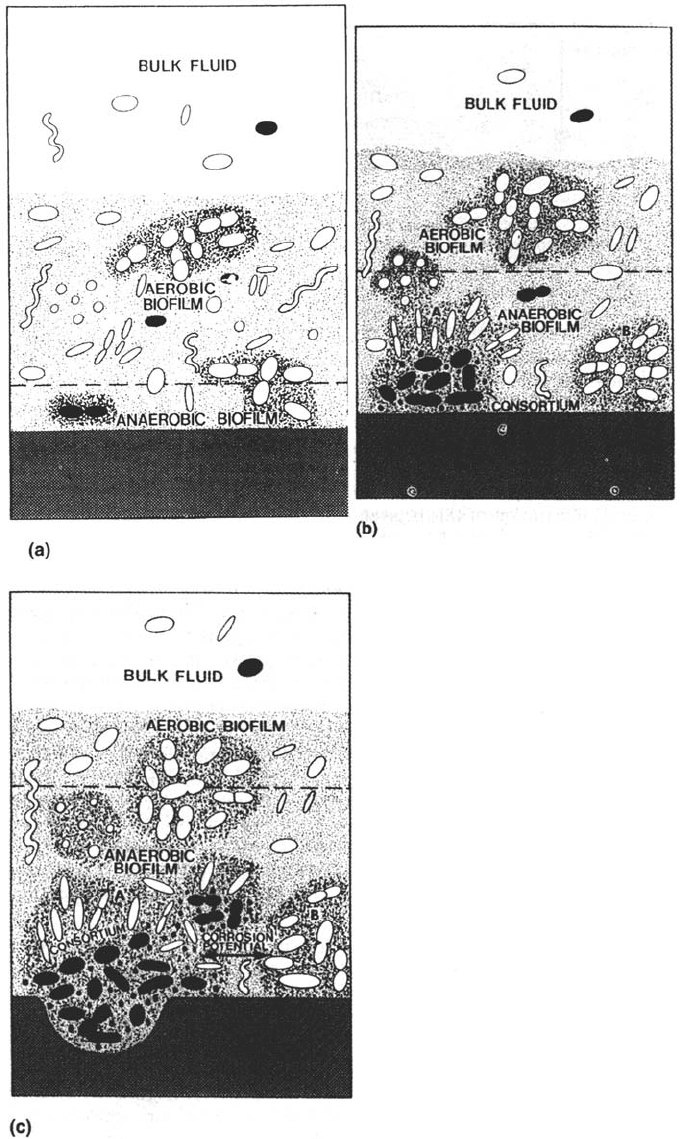
584 Thierry and Sand
Copyright © 2002 Marcel Dekker, Inc.
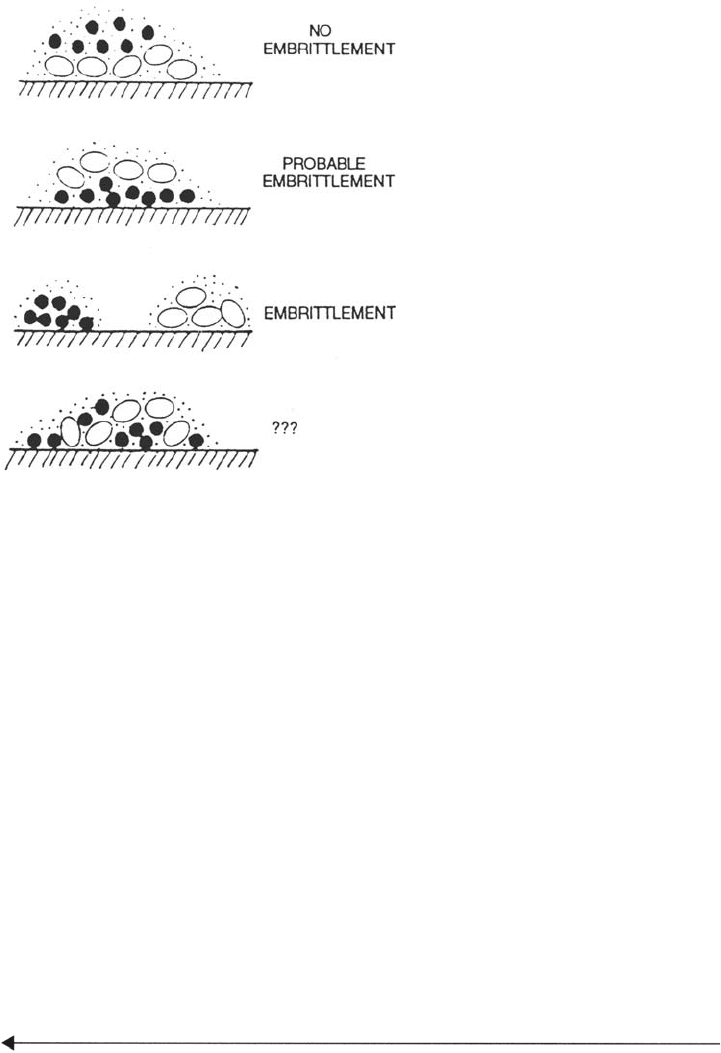
From these studies it seems clear that, even if studies of microorganisms in
isolation (i.e., in pure cultures) give valuable information concerning the mechanisms
of MIC of a particular species in a given environment, more work should be done
on the effect of mixed bacterial populations on the mechanisms of MIC.
Mechanisms of Microbially Induced Corrosion of Stainless Steels
and Titanium
There are large numbers of reported case histories of MIC on stainless steel in
water and aqueous waste systems. They are related to different industrial applications
such as freshwater storage and circulation systems in nuclear power plants [103,
113,116,142] and cooling water systems in chemical process industries [117,118].
There are basically three cases: (a) crevice corrosion under unexpected deposits, (b)
sensitivity of pitting and crevice corrosion to trace of H
2
S, and (c) crevice corrosion
in natural seawater. Most of these reports are not well documented concerning the
microorganisms involved in the process. However, some general features are
Microbially Influenced Corrosion 585
Figure 8 Diagrammatic representation of the effects of the spatial arrangement of hydrogen
producers and consumers in a natural biofilm on the embrittlement of metals (black circles
represent hydrogen producers, open ovals represent hydrogen consumers.) (From Ref. 133.)
Figure 7 Diagrammatic representation of the formation of microbial consortia and their
influence on the corrosion processes. (a) When the film becomes sufficiently thick its inner
part will be anaerobic with the possible development of SRB microcolonies (black cells).
(b) The SRB attracts secondary colonizers by its metabolic products and forms a consortium
with them. (c) The development of local areas with varying physicohemical parameters
leads to pitting corrosion. (From Ref. 21.)
Copyright © 2002 Marcel Dekker, Inc.
common in almost all cases: (a) MIC is reported for the alloys with a relatively low
content of molybdenum; (b) pitting or crevice corrosion generally occurs at or around
welds (i.e., near the fusion line, or with sensitization in the heat-affected zones); (c)
discrete localized deposits are often found in direct connection, with or close to the
corrosion sites.
The higher sensitivity to MIC of welds compared with the unwelded metal
may be explained by a difference in surface roughness or/and chemical composition
that facilitates the colonization of the surface by microorganisms.
In some reports, a higher sensitivity to MIC of the delta-ferrite in duplex welds
has been reported [12,67], and in others both the austenite and delta-ferrite phases
have been shown to be sensitive to MIC [11]. There is also evidence that surface
treatment of welds, such as solution annealing and pickling or polishing and grinding,
may result in welds that are less susceptible to microbial corrosion [11,134].
The observation of localized deposits is often associated with the presence of
slime-forming bacteria such as Pseudomonas and iron bacteria. These bacteria
consume oxygen diffusing into the deposit and thus create a differential aeration
cell that may initiate crevice corrosion. Under the deposit, the environment
becomes anaerobic with the subsequent possibility of growing SRB in a scenario
similar to that described for microbial biofilms. Besides the effect of concentration
cells, the specific role of metal-concentration/oxidizing bacteria such as iron- and
manganese-oxidizing bacteria in the initiation of localized corrosion is often men-
tioned [29]. By controlling the redox potential of Fe
2+
/Fe
3+
and/or Mn
2+
/Mn
4+
,
these bacteria may polarize the metal surface at a potential at which Fe
3+
and/or
Mn
4+
may exist. Together with the accumulation of chloride ion (due to the
necessity of preserving electroneutrality), this leads to the formation of FeCl
3
and
MnCl
4
solutions that are aggressive to stainless steels. It is well known that both
situations facilitate the breakdown of the passive film with crevice corrosion and/or
pitting corrosion as a result.
Sulfate-reducing bacteria have also been reported to be responsible for pitting
corrosion on stainless steels in aqueous environments. The mechanisms proposed are
mostly related to iron and steel. However, a different mechanism has been proposed
in which the role of thiosulfate in the microbial pitting of stainless steel has been
emphasized [137]. The same authors have also demonstrated clearly that SRB-
induced pitting corrosion of stainless steel is unlikely to occur in a uniformly
anaerobic SRB medium, whereas it will occur when the anaerobic sites are coupled
to an oxygen cathode [136].
This discussion is related almost solely to alloys with a relatively low
molybdenum content, but the high molybdenum alloy stainless steels may also be
susceptible to MIC. 904L, AL-6X, and 254 SMO were attacked by bacteria in pure
cultures of Desulfovibrio desulfuricans and Hyphomicrobium indicum. The corrosion
attack seems to be localized at the grain boundaries [108]. However, MIC on highly
alloyed stainless steels has never clearly been reported in natural environments.
Besides the reports of MIC described above that are mainly related to water
with relatively low salt content such as fresh water, an increase in the corrosion
potential has also been reported for stainless steels exposed to natural seawater. The
ennoblement of the corrosion potential has been observed for various stainless steel
compositions (i.e., austenitic, ferritic, duplex, and superaustenitic stainless steels)
exposed in natural seawater with different salinities and at different temperatures
586 Thierry and Sand
Copyright © 2002 Marcel Dekker, Inc.
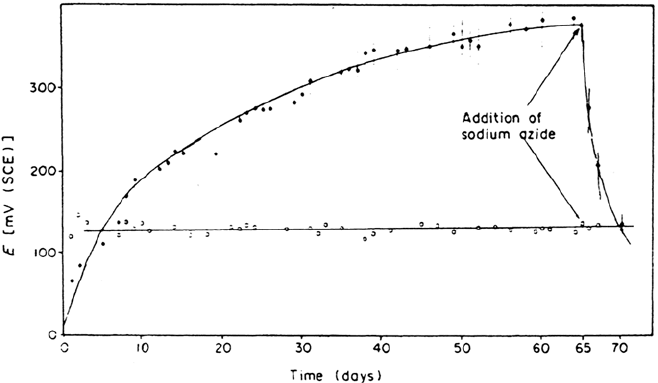
[3,28,30,61,62,82]. It is well known that in a given steel/environment system,
localized corrosion occurs on stainless steel when the corrosion potential becomes
greater than the pitting potential. Hence, the result of the potential ennoblement is
that there is a higher probability of localized corrosion of stainless steel in a natural
environment than in artificial seawater. This effect has been connected with the
presence of a biofilm on the metal surface as shown in Figure 9. The corrosion
potential of 21Cr-3Mo steel increases as a function of time in natural seawater to
a value of about 400 mV/ECS, whereas it remains unchanged in sterilized seawater.
When a specific inhibitor of respiratory activity (sodium azide) is added to both
natural and sterilized seawater, a rapid decrease in the corrosion potential is
observed in the case of natural seawater but it remains unchanged in sterile
seawater [109]. The increase of the corrosion potential on stainless steel has
been correlated with an increase of the rate of the cathodic reaction, e.g., the
reduction of oxygen. This is shown in Figure 10. During the development of
the biofilm at the stainless steel surface, an important depolarization of the
oxygen reduction reaction occurs. This will lead to a higher rate of propagation
of localized corrosion on stainless steel. Hence the effect of the biofilm settlement
on stainless steel may be summarized as follows:
1. The corrosion potential of stainless steel increases in the noble direction,
which increase the probability of localized corrosion.
2. A higher corrosion propagation rate is observed once localized corrosion
develops.
3. Higher galvanic currents between stainless steel coupled to less noble
materials are measured.
The study of the mechanisms of the ennoblement of stainless steel is complex,
as seawater constitutes an environment in which numerous parameters can act.
Microbially Influenced Corrosion 587
Figure 9 Corrosion potential as a function of exposure time for 21Cr-3Mo steel in natural
seawater (black circles) and in artificial seawater (white squares). Time of addition of sodium
azide is indicated by arrows. (From Ref. 109.)
Copyright © 2002 Marcel Dekker, Inc.
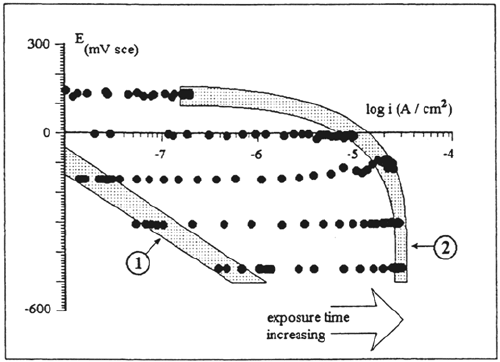
A literature review of the subject has been published [16]. It has been shown that
the potential ennoblement in the presence of biofilms is probably due to an
enhancement of the cathodic reduction of oxygen by (a) a decrease in pH at the
metal-biofilm interface, (b) the formation of macrocyclic organometallic catalysts,
such as porphyrins and phtalcyanins, (c) bacterially produced enzymatic catalysis, or
(d) the production of hydrogen peroxide within the biofilm or ie. the catalyse of the
oxygen reduction by manganese. More recent literature on the subject seems to
confirm the role of enzymes in the depolarization of the oxygen reduction reaction on
stainless steel [1,32]. A possible mechanism in which the potential ennoblement
results from enzymatic competition between the production of hydrogen peroxide
and acids by oxidases and the enzymatic consumption of these two chemicals has
been proposed. This is schematically shown in Figure 11. Based on a large amount of
biofilm growth on stainless steel at different European locations, it has been shown
that enzymes entrapped in the EPS matrix of the biofilm could be responsible for the
ennoblement of the corrosion potential on stainless steel [110]. Finally it should be
noted that potential ennoblement of stainless steel has also been reported for stainless
steel exposed to river water [49]. The mechanisms are, however, similar to that of
seawater.
According to a literature review, there is no reported case of MIC on titanium
[72].
Mechanisms of Microbially Induced Corrosion on Aluminum
and Aluminum Alloys
Case histories of MIC on aluminum and aluminum alloys have been mainly
reported for aircraft fuel storage tanks and heat exchanger tubes using water with
different salinities. In all cases, pitting corrosion occurred.
Even though these cases are not as well documented as MIC on iron and steel,
the possible mechanisms and microorganisms involved have been given for the
588 Thierry and Sand
Figure 10 Oxygen reduction current density on stainless steel exposed to natural
seawater and continuously polarized at fixed cathodic potentials. The envelopes of curves
1 and 2 correspond to the set of data on clean and already fouled stainless steel surfaces,
respectively [83].
Copyright © 2002 Marcel Dekker, Inc.
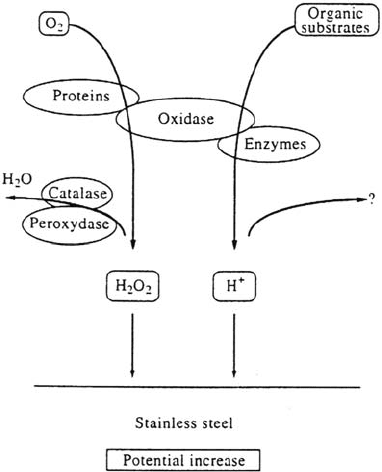
microbial contamination of aircraft aluminum fuel tanks [17,52]. Some of the
most predominant bacteria and fungi are Pseudomonas aeruginosa, Aerobacter
aerogenes, Desulfovibrio, and Cladosporium species. The corrosion occurs mainly
in the water phase of the fuel-water mixture at the bottom of the tanks and at the
fuel-water interface. The mechanisms involved are the same as those already
given for iron and steel: (a) the production of corrosive metabolites by bacteria
and fungi (organic acids and hydrogen sulfide), (b) the creation of differential
aeration cells, (c) the transformation of nitrate (corrosion inhibitor for aluminum)
to nitrite, and (d) extracellular activity resulting in the removal of major or minor
metallic atoms from the basic structure of the alloy [92].
Mechanisms of Microbially Induced Corrosion on Copper
and Copper Alloys
As in the case of aluminum and aluminum alloys, the MIC of copper and its
alloys is not very well documented. This is probably due to the general belief
that copper is toxic to microorganisms, which is not, however, the case for all
microorganisms. As an example, bacteria of the genus Thiobacillus may tolerate
copper concentrations up to 6%.
Case histories of MIC on copper and its alloys have been reported for piping
systems and heat exchangers. Whereas heat transfer problems are observed with
growing biofilms, the corrosion increases after the death of the microorganisms
within the biofilm. This is believed to be due to the production of ammonia and
carbon dioxide upon the death of cells that may result in pitting corrosion and/or
stress corrosion cracking for copper and its alloys [72,92].
Microbially Influenced Corrosion 589
Figure 11 Hypothetical mechanism of the stainless steel ennoblement in natural
seawater [32].
Copyright © 2002 Marcel Dekker, Inc.
The production of hydrogen sulfide by sulfate-reducing bacteria is also
believed to lead to pitting corrosion and stress corrosion cracking on copper
and copper alloys. In this case the corrosion is due to the formation of a thick
nonadherent layer of chalcocite (Cu
2
S) or covellite (CuS
1–x
). Pitting corrosion
may occur where the copper sulfide film has been removed, with the cathodic
reaction taking place on the intact copper sulfide film [79].
Microbially induced pitting corrosion has also been observed in isolated
locations in Europe, the United States, Australia, and New Zealand in potable water
reticulation systems plumbed by copper [131,138]. This results in a contamination
of the water such that the water is in breach of the maximum copper levels permitted
by the U.S. EPA lead-copper rule (i.e., 1.3 ppm) [126]. Generally a biofilm is
observed under a black deposit of copper (II) oxide and basic copper salts.
Although the link between the pitting corrosion of copper and the microbial activity
has been clearly established, the exact mechanism by which microorganisms
increase the probability of initiation of pitting corrosion on copper is not known
at the present time. However, it has been suggested that the role of the biofilm
could be to oxidize copper (I) oxide to copper (II) oxide [15]. Finally it should be
noted that an increase in the bicarbonate level of the water as well as a change in
the cholride/sulfate ratio with increasing chloride content yielded a decrease in the
initiation and propagation of pitting corrosion copper, respectively [131].
Other Construction Materials
Mineral Materials
Concrete is a mixture of a coarse-grained aggregate, hydraulic binding agents
(cement, gypsum, lime, asphalt, sulfur, and resin), and water (except in the case of
sulfur and resin, where water is not needed). For a limited period after preparation,
the mixture can be molded into different shapes until hardening occurs as a result
of chemical reactions between the components.
Ceramics are products made from fired clay–containing masses such as
kaolin. The products are distinguished by the grain size of the clay and additives
used and the firing temperature.
Glass is a transparent, sometimes colored, inorganic material, which is fragile
and predominantly noncrystalline. It has no well-defined melting point, but with
continuous heating it changes from being viscous to a soft and finally thin fluid
state (i.e., an undercooled melt without cyrstallization).
Natural stone originates from rocks obtained from quarries in natural deposits.
Rocks are defined as natural, solid formations of the earth’s crust. They consist of
a mixture of minerals or a single mineral and may contain organic residues.
Characteristics are the composition of primary (main), secondary, and auxiliary
minerals, the structure, and the stratification. Three main groups need to be
distinguished. Magmatic rocks are molten masses in the earth’s crust (basalt, granite,
etc.). Sedimentary rocks contain grains (often quartz) held together by a binding
material (often calcareous or siliceous, such as gypsum, limestone, sandstone,
schist). Metamorphic rocks are formed by transformation from magmatic or
sedimentary types by heat and pressure (quartzite, marble, crystalline schist).
590 Thierry and Sand
Copyright © 2002 Marcel Dekker, Inc.
All these materials are characterized as nonmetallic mineral materials. A
biogenic attack can be caused by almost all microorganisms and by the mechanisms
described above [7,25,34,68,71,80,85,86,90,91,97–100]. Only the action of
exoenzymes, emulsifying agents, and organic solvents seems to be negligible for
these materials. However, if mixtures of mineral materials with organic polymers are
used to improve the properties, as in resin-modified mortars or in resin- or sulfur-
bound concrete, the latter mechanisms may contribute to some extent.
Organic Polymers of Natural and Synthetic Origin
To the group of construction materials [54] belong, besides stone, those that have
been used since humans began construction work. Wood is the oldest known con-
struction material. Because of its unique characteristics, it is still in use today.
The main components of wood are cellulose, polyoses (hemicelluloses), and lignin.
The proportions are 40–50%, 15–35%, and 25–35%, respectively. Extractable com-
pounds such as terpenes, waxes, or tannins may account for 1–3% and mineral
compounds for 0.1–0.5%. The tensile strength of wood is determined by the cellulose
cell structure. The cellulose molecule contains from 10,000 up to 14,000 β-(1,4)-
glycosidically bound glucose units and represents the valuable part of wood for
further products such as paper, cardboard, foils, films, and fibers.
Polyoses are also polysaccharides, but with lateral chains and ramifications.
Between 50 and 200 saccharide molecules are polymerized. Galactoglucomannan
or 4-O-methylglucuronoxylan is the main constituent. The polyoses connect the
polysaccharides with the lignin in the cell wall. They determine the swelling and
shrinkage of wood.
Lignin, either guaiacylpropane solely or combined with syringylpropane, is a
complex molecule responsible for the pressure resistance of wood. The extractable
substances such as terpenes provide the resistance against degrading microorganisms,
e.g., bacteria and/or fungi. From these two groups and lichens, wood-degrading
microorganisms originate. The main action is due to exoenzymes degrading the
highly polymerized substances into water-soluble monomers or dimers. Similar
mechanisms are involved in the degradation of wood-based materials such as
laminated timber, blockboard, plywood, chipboard, and fiberboard. Plywood and
chipboard may be especially endangered by biogenic attack because the binders
used for these materials may increase their susceptibility. Binders may be
urea-formaldehyde resins, phenol-formaldehyde resins, cresol-formaldehyde
resins, isocyanates, etc., which may serve as a nitrogen source.
Besides wood, construction materials are made from plastics. These are
materials consisting mainly of macromolecular organic compounds obtained
synthetically or by modification of natural products. On application of heat and
pressure, synthetics melt and become formable. Three main groups of synthetic
polymers may be distinguished.
The term polycondensates covers phenolic, urea, thiourea, melamine,
unsaturated polyester, alkydic, and allyl resins as well as silicones, polyimides,
and polybenzimidazoles in the group of duroplasts. To the category of thermoplasts
belong polyamides, polycarbonates, polyesters, polyphenylene oxides, polysulfones,
and polyvinyl acetals.
Polymerizates are generally thermoplasts (polyethylenes, polypropylenes, poly-
1-butenes, poly-4-methyl-1-penteneionomers, polyvinyl chlorides, polyvinylidene
Microbially Influenced Corrosion 591
Copyright © 2002 Marcel Dekker, Inc.
chlorides, polymethyl methacrylates, polyacrylonitriles, polystyrenes, polyacetals,
fluorosynthetics, polyvinyl alcohols, polyvinyl acetates, and poly-p-xylylenes).
Polyadducts include duroplasts such as epoxidic resins and cross-linked
polyurethanes as well as thermoplasts such as linear polyurethanes and chlorinated
polyethers.
Although natural compounds are believed to be degradable by microorganisms
in general—microbiological omnipotence—this does not always apply to synthetic
polymers. These substances belong at least partially to the xenobiotica, which
are known to be resistant to biological attack. For a few synthetic resins,
experience of biodegradability has been available for nearly a century. Perspex has
been demonstrated to be biologically not degradable. The same holds for
nonflexible PVC. The main groups of resins may be characterized with regard to
their biodegradability as follows. Polyurethanes with molecular weights of 10,000
and above are generally believed to be easily biodegradable. However,
introducing substituents into the molecule may modify this. Polyethylenes with
molecular weights of 1500 to 7000 range from resistant to easily biodegradable.
Polypropylenes (MW 25,000 to 500,000) also vary from resistant to easily
biodegradable. Polymethyl methacrylates (MW 500,000 to 1,000,000) and
polyamides (MW 10,000 to 100,000) are comparable to those already mentioned.
Polystyrenes (MW 200,000 to 300,000) are generally believed to be resistant to
biological attack. The same holds for polyvinyl chlorides (MW 30,000 to 520,000)
and polytetrafluoroethylenes (MW 500,000 to 5,000,000).
Besides the basic polymers, the final products often contain a variety of
additives to adapt a resin to the intended purpose. This includes softeners (may
make up to 60% of the final product), stabilizers, antioxidants (0.01–2%), antistatics,
light-protecting agents (0.1–1%), optical brighteners, anti-ignition agents (up to
30%), microbicides (0.3–5%), lubricating agents, filling agents (up to 30%),
accelerators, and pigments (0.02–5%).
It is not possible in the available space to mention all the compounds used. It is
important that the majority of these additives are organic compounds, which are often
easily biodegradable. As a consequence, a synthetic polymeric material may not be
biodegradable with respect to the polymeric backbone, the synthetic polymer, but it
becomes biodegradable because of the additives used. A result may be an
embrittlement of the material (e.g., flexible PVC after being used several times). Even
if a synthetic material is not attacked structurally, depending on the use, microbial
growth may cause deterioration associated with, e.g. aesthetically intolerable color
changes. A variety of microorganisms produce pigments (mainly black, some also
blue or red) that may diffuse into the resin, causing a change in appearance.
Rubber, of either natural or synthetic origin, also contains because of its method
of production many biodegradable compounds. It is used for purposes in which it
needs to maintain its elasticity for a long time. Generally, synthetic rubbers are more
stable than natural ones. In any case, rubbers may be attacked by microorganisms.
COUNTERMEASURES
A large number of approaches may be used to prevent or minimize the
microbiological degradation of construction materials. The choice of the proper
592 Thierry and Sand
Copyright © 2002 Marcel Dekker, Inc.
